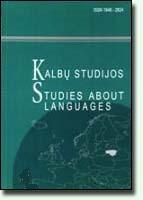Automatizuotas lietuvių kalbos morfologinio daugiareikšmiškumo ribojimas
Automated Disambiguation Of Lithuanian Morphological Ambiguity
Author(s): Erika Rimkutė, Gintarė GrigonytėSubject(s): Language and Literature Studies
Published by: Kauno Technologijos Universitetas
Keywords: morphological ambiguity; statistical and logical methods
Summary/Abstract: We describe methods for disambiguation of Lithuanian morphological ambiguity. The methods we present can be automatic and automated. Automatic are statistical and logical methods, also the removal of unreal homonyms. Automated methods are: the removal of unreal homoforms, disambiguation of non-inflective and inflective parts of speech. We need various rules for disambiguation of non-inflective parts of speech. Analysis of punctuation, statistical date from Contemporary Lithuanian Language Corpus, syntactic analysis, semantics, exhaustive analysis of all the text or a few nearest sentences, transformation in more clear words, morphological information, etc. can be useful for this disambiguation. The best method for disambiguation of inflective parts of speech is an automatic syntactic analysis. Syntactic rules we present are based on Dependency Grammar. These rules consist of two levels: the level of word groups (lower level) and the level of the combinations of word groups (upper level). It is very important to recognize which word is the main, i.e. governing, and dependent word in automatic syntactic analysis. Other relation parameters are: word order, insertion and priority (in some cases). We also have described the methodology of syntactic rules extraction in this article. Statistical and logical methods for disambiguation of morphological ambiguity gives good results – more than 90% of forms can be disambiguated correctly. At the meantime we have no concrete results what is an accuracy of automated disambiguation but it is clear that the automatic syntactic analysis can resolve many cases of morphological ambiguity of inflective parts of speech.
Journal: Kalbų Studijos
- Issue Year: 2006
- Issue No: 9
- Page Range: 30-37
- Page Count: 6

